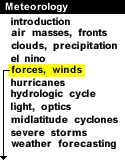
|

Graphic by: Yiqi Shao
The weight of the air above an object exerts a force per unit area upon that object and this force is called pressure. Variations in pressure lead to the development of winds, which in turn influence our daily weather. The purpose of this module is to introduce pressure, how it changes with height and the importance of high and low pressure systems. In addition, this module introduces the pressure gradient and Coriolis forces and their role in generating wind. Local wind systems such as land breezes and sea breezes will also be introduced. The Forces and Winds module has been organized into the following sections:
| Sections
Last Update: 09/02/99 |
Pressure
Introduces pressure, associated characteristics, and high and low pressure centers.
Pressure Gradient Force
Coriolis Force
Geostrophic Wind
Gradient Wind
Friction
Boundary Layer Wind
Sea Breezes
Land Breezes
Acknowledgments
|
The navigation menu (left) for this module is called "Forces, Winds" and the menu items are arranged in a recommended sequence, beginning with this introduction. In addition, this entire web server is accessible in both "graphics" and "text"-based modes, a feature controlled from the blue "User Interface" menu (located beneath the black navigation menus). More information about the user interface options, the navigation system, or WW2010 in general is accessible from About This Server.

El Nino |
|

Pressure |



